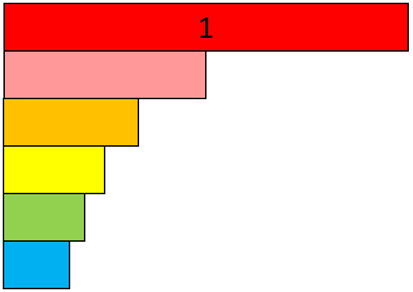Purpose
The purpose of this activity is to support students connecting the words and symbols for unit fractions with visual amounts. In this lesson the one whole is presented as a single strip.
Achievement Objectives
NA2-1: Use simple additive strategies with whole numbers and fractions.
NA2-5: Know simple fractions in everyday use.
Required Resource Materials
- Copymaster (Laminate and cut. You may want to make two pages of the coloured strips)
Activity
- Show students the one whole (1) strip made from the Copymaster.
Here is one strip. (You might contextualise it as a food item or another linear object like a rope or ribbon)
Place a single pink strip below the 1 strip.
What size is this piece? Can you use a fraction name?
How do you know it is one half? How could you check?
Students should know that two halves make 1. Produce another pink strip and invite a student to check.
- Show the collection of symbol and word cards. You might complement these with te reo Māori kupu. Practise reading the cards a few times then ask individual students to find a given card. For example:
Find the words for “One quarter”
Find the symbol for “One sixth”
Look for students to associate the denominator of the fraction (bottom number) with the word. For example, hear “One sixth” and look for 1/6.
- Match the word and symbol card for one half with the strip and put them aside. Show the students a single yellow strip and place it below the 1 strip.
What size is this piece? Can you use a fraction name?
How do you know it is one quarter? How could you check?
Do students know that four one quarter strips placed end-on-end (iterated) make 1?
Confirm that the yellow strip is one quarter by placing the remaining three yellow strips below 1.
Match the symbol and word cards with the one quarter strip and set them aside.
- Follow the same steps, with students working in pairs, to match the words and symbols for the other unit fractions, possibly in the order of one fifth, one third, then one sixth. Consider which grouping will be best to encourage scaffolding, extension, and the development of understanding for your students.
- Ask “which is longer?” questions and look for students to anticipate the size relationship. For example:
Is one half longer than one fifth?
Is one quarter longer than one third?
- Have students check the comparative lengths using the fraction strips.
Is there a way to know which fraction is shorter, without needing to check with the strips?
Look for students to understand that the more equal parts they cut the whole into, the smaller the parts become. It is like sharing a fruit loop among more friends.
- Together, order the fraction symbols from shortest to longest. Let students anticipate the order first, then check the correct order using the strips.
Is there a pattern?
Students should notice that as the denominator increases the size of the fraction decreases.
How do write one eighth in numbers?
Where would that fraction go among these cards?
Next steps
- Explore the special nature of words for simple fractions. Fractions such as “one sixth” and “one eighth” show a similar code that prevails to further sharing of one.
How could we make tenths? …twelfths?...sixteenths?
If we used “th” for the simplest fractions, what would one half be? (One twoth) …one third be? (one threeth) …one quarter? (one fourth).
- Look at the spatial pattern in the size of fractions that is not obvious when placing the fraction symbols.
The size difference between consecutive unit fractions gets less and less.
Look at the pattern.
How long is one seventh? …one eighth? …one ninth?
- Use discrete area models and number lines to explore, order, and compare unit fractions.
Attachments
fraction-strips-symbols.pdf259.23 KB
Add to plan
Level Two